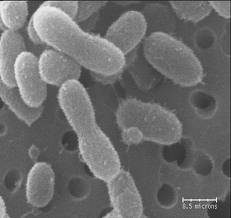Chryseobacterium greenlandense
A Microbial Biorealm page on the genus Chryseobacterium greenlandense
Classification
Higher order taxa
Domain (Bacteria); Phylum (Bacteroidetes); Class (Flavobacteriia); Order (Flavobacteriales); Family (Flavobacteriaceae); Genus (Chryseobacterium)
Species
Chryseobacterium greenlandense
Description and significance
Chryseobacterium greenlandense is a newly described psychrotolerant ultramicrobacterial species found 3,043 m deep in a Greenland glacier. [3] C. greenlandense are Gram-negative, non-flagellated and rod-shaped with an average cell volume of 0.08 μm3 [3]. Optimal growth occurs at 30°C, though growth range is 1—37°C (3). The ice core C. greenlandense was isolated from is 120,000 years old, indicating that cells remain viable at low temperatures for hundreds of thousands of years [2][4]. It has been suggested that ultramicrobial species living in glacial ice, such as C. greenlandense, may be well adapted to harsh environments with low nutrient concentrations and may contain novel metabolic processes [4]. Further study may reveal C. greenlandense as an analog species for subzero extraterrestrial environments such as Mars [4].
Genome structure
A complete genome sequence is not available for this species, though 16S ribosomal gene has been partially sequenced with 1,434 bp identified [3]. Typical of the genus, C. greenlandense is closely related to other Chryseobacterium species based on 16S rRNA gene sequencing, the nearest relative being C. aquaticum at 99.3% [1][3]. The guanine-cytosine content is 39.6—41.6 mol% [3].
Cell and colony structure
C. greenlandense are orange in color due to production of a flexirubin type pigment [3]. Cells are ultrasmall with dimensions of 0.6—1.2 μm × 0.4—0.5 μm (3). Buds and small protrusions (“blebs”) appear on the surface of cells, though it is unclear whether these are different structures or what their function may be [3]. Cells produce considerable exopolymeric secretions thought to assist with adherence to substrates and possibly provide gliding motility, which may explain swarming-like behavior observed under certain conditions [3]. Colonies appear yellow to dark orange [3]. Round, convex and smooth-edged after incubation for 2—3 days, colonies expand and become rhizoid after longer periods of incubation [3].
Metabolism
Differential tests indicate that C. greenlandense are aerobic chemoorganotrophs, consistent with the genus description, but are capable of growing in microaerophilic conditions [1][3]. Cells assimilate glucose and maltose [3].
Ecology
The ice core C. greenlandense was isolated from represents an ecologically diverse community, containing nearly 800 successfully isolated microorganisms from numerous genera with at least 7 isolates representing new species [5]. No information is yet available highlighting specific interactions between C. greenlandense and other organisms in its habitat. It is believed that microbial communities in glacial ice dwell primarily in thin veins containing nutrient-providing liquid [2]. Metagenomic page: http://www.ncbi.nlm.nih.gov/nuccore/FJ932652
Pathology
No information is available indicating C. greenlandense cause disease. The species is sensitive to ampicillin, ciprofloxacin, erythromycin, nalidixic acid, neomycin, penicillin, rifampicin and vancomycin while resistant to bacitracin and streptomycin [3].
References
[1] Bernardet, Jean-FrançoIs; hugo, CelIa J.; BruunKrieg, BrIta. Genus X: Chryseobacterium. Bergey’s Manual of Systematic Bacteriology, Vol. IV. 2nd ed. N.R.; Ludwig, W.; Whitman, W.B.; Hedlund, B.P.; Paster, B.J.; Staley, J.T.; Ward, N.; Brown, D.; Parte, A. (Eds.) 2010. 180-197. DOI: 10.1007/978-0-387-68572-4
[2] Junge, Karen; Christner, Brent; Staley, James T. Diversity of Psychrophilic Bacteria from Sea Ice and Glacial Ice Communities. Extremophiles Handbook. Springer Online. 2011. 793-810. DOI: 10.1007/978-4-431-53898-1_39
[3] Loveland-Curtze, Jennifer, Miteva, Vanya I., Brenchley, Jean E. (2009) Novel Ultramicrobacterial Isolates from a Deep Greenland Ice Core Represent a Proposed New Species, Chryseobacterium greenandense sp. nov. Extremophiles 14: 61-69. DOI: 10.1007/978-4-431-53898-1_39
[4] Miteva, Vanya I., Brenchely, Jean E. (2005) Detection and Isolation of Ultrasmall Microorganisms from a 120,000-Year-Old Greenland Glacier Ice Core. Appl. Environ. Microbiol. 71(12): 7806. DOI: 10.1128/ AEM.71.12.7806-7818.2005
[5] Miteva, Vanya I., Sheridan, P.P., Brenchely, Jean E. (2004) Phylogenetic and Physiological Diversity of Microorganisms Isolated from a Deep Greenland Glacier Ice Core. Appl. Environ. Microbiol. 71(12): 7806. DOI: 10.1128/AEM.70.1.202-213.2004
Edited by Daniel Leonard of Dr. Lisa R. Moore, University of Southern Maine, Department of Biological Sciences, http://www.usm.maine.edu/bio

